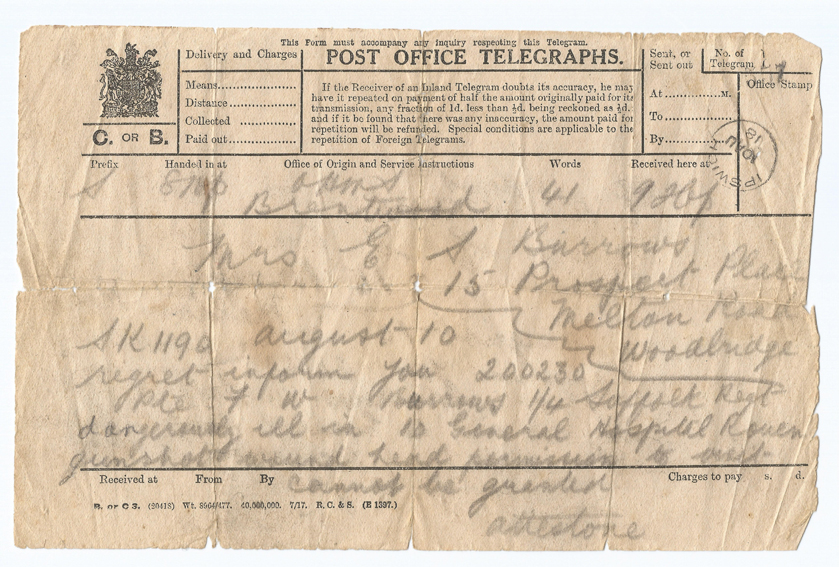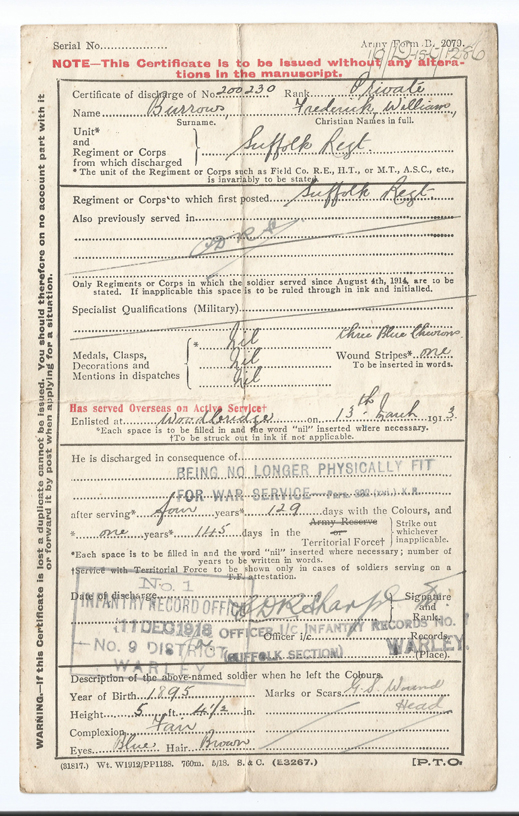Frederick William Burrows was born on 25th February 1895 in Holloway, London. Soon after he turned eighteen, on the 13th March 1913, Frederick joined the 4th Suffolk Regiment. On 2nd August 1914, when Frederick was attending the annual training camp in Great Yarmouth, orders were received to break camp and return to civilian life due to the imminent outbreak of war.
Upon returning to Woodbridge, the senior officers decided to keep the men together; this was to ensure the battalion would be available for mobilisation as soon as war was declared. Late in the evening on Tuesday 4th August, news of the declaration of war reached Woodbridge along with the King’s proclamation, which embodied all Reservists and Territorial Forces members.
The Woodbridge Company of the 4th Suffolks boarded a train taking them to their war station at Felixstowe. When the 4th Suffolks were sent to France on 9th November 1914 though, Frederick stayed in England—he was posted to Cromer with the other men from the battalion that were either too old, unfit or had not signed up to serve abroad. It was not until conscription was introduced, in 1916, that Frederick rejoined his colleagues in the 4th Suffolks on the front line in France.
By February 1918, the 4th Suffolks had become a “Pioneer” battalion, providing the Royal Engineers with skilled labour, assisting them in digging trenches, building roads and other similar duties often on the front line.
In early August, “A” Company and Frederick’s “D” Company were stationed at the Bois Escardonneuse, near Lahoussoye, in the Somme region, when they were sent to the front line in preparation for an attack on the 8th August. By midnight, both “A” and “D” companies were in dug-outs in a gully to the north-west of Sailly-le-sec.
At 04:20 the attack commenced and the 4th Suffolks built a line of posts to protect the left flank of the divisional flank. During the work, nine men were killed and twenty others wounded, including Frederick who was shot in the head. He survived this injury and was taken first to the 2/1 Home Counties Field Ambulance at Smith’s Farm and then on, to the main dressing station at Querrieu. His condition was so serious, however, that he was transferred to the 10th General Hospital in Rouen.
Frederick’s mother received a letter written on the 11th August from a nursing sister at the hospital:
Dear Mrs Burrows,
I am sorry to tell you that your son Pte. F W Burrows 1/4 Suffolk Reg has been badly wounded (G S Wound Head & compound fracture) and is dangerously ill. We hope with treatment and care his condition may soon improve. I need scarcely tell you, we shall do all we can for his welfare and comfort believe me.
Yours very truly,
K I Jordan (Sister)
Frederick returned to Britain for further treatment at the 2nd Western General Hospital in Manchester. There, he underwent surgery on his wound that was to leave him disabled for the rest of his life. Frederick was discharged from the army on 11th December 1918 and, for his war service, he received the British War and Victory Medals along with the Silver War Badge. Frederick continued to live in Prospect Place, working as a journeyman upholsterer and looked after by his mother until his death in 1941 at the age of forty-six.

Telegram sent to Frederick's mother when he was wounded in August 1918

Frederick's discharge paper.

